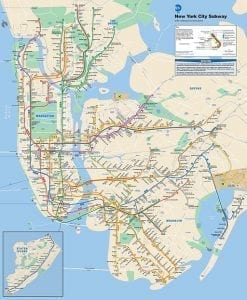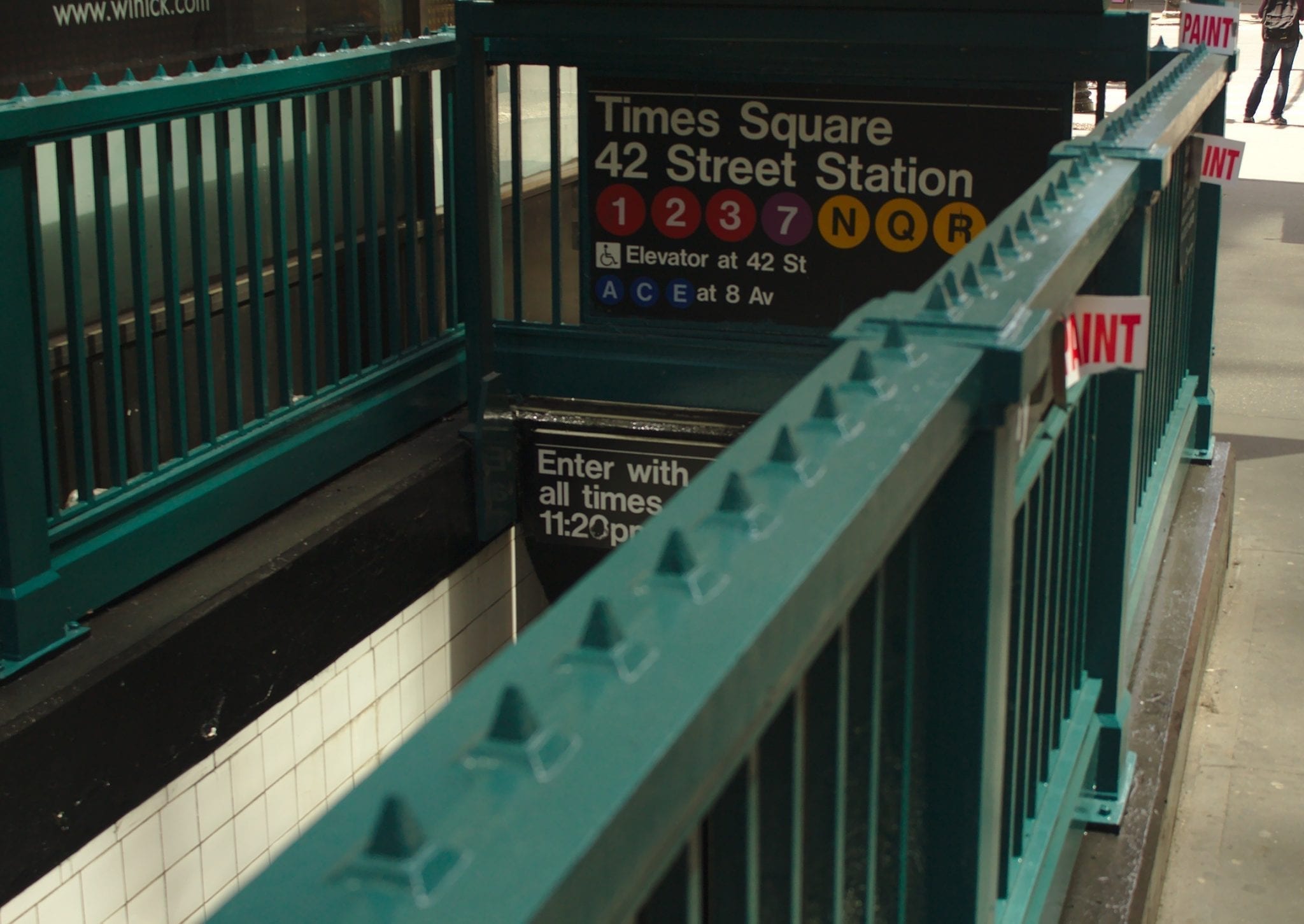The second lawsuit, filed in 2019 in federal court in the Southern District of New York, alleged that the MTA consistently renovates and rehabilitates subway stations without adding stair-free access as part of those renovations.
New York, NY — Both the Southern District of New York (the federal court) and the New York State Supreme Court (state court) have granted final approval to a settlement agreement that will make the New York City subway accessible for more than half a million people with disabilities who cannot use stairs to access the system. Presently, only about a quarter of stations are usable by people with disabilities affecting their mobility, but under the terms of the agreement, the MTA will add elevators or ramps to create a stair-free path of travel at least 95% of the system’s currently inaccessible subway stations by 2055. Read the Settlement Agreement.
As described in the Settlement Agreement, the MTA commits to dedicating 14.69% of each of its 5-year Capital Plan budgets to station accessibility, barring unexpected critical needs. Should such unexpected needs arise, the MTA commits to devoting no less than 8% of its total Capital Plan to station accessibility. The Capital Plan has never before mandated a minimum, let alone such a significant investment, in making stations accessible to people with disabilities. The Agreement also ensures that stations will be made accessible as part of many renovation and rehabilitation projects. In total, the MTA commits that in addition to the 81 stations currently slated for accessibility in the 2020-2024 Capital Program, 85 more stations will be accessible by 2035, another 90 by 2045, and the final 90 by 2055.
The Settlement Agreement resolves two lawsuits brought against the MTA by plaintiffs Center for Independence of the Disabled, New York (CIDNY), Brooklyn Center for Independence of the Disabled (BCID), Bronx Independent Living Services (BILS), Harlem Independent Living Center (HILC), Disabled In Action of Metropolitan New York (DIA), New York Statewide Senior Action Council (“StateWide”), Sasha Blair-Goldensohn, Dustin Jones, Jessica De La Rosa, and Jean Ryan, represented by Disability Rights Advocates (DRA) and Sheppard, Mullin, Richter & Hampton LLP (Sheppard Mullin). The first lawsuit, filed in 2017 in New York State Supreme Court, alleged violations of the New York City Human Rights Law because of the overwhelming inaccessibility of the current subway system. Read the complaint here. The second lawsuit, filed in 2019 in federal court in the Southern District of New York, alleged that the MTA consistently renovates and rehabilitates subway stations without adding stair-free access as part of those renovations. Read the complaint here. The settlement agreement, granted final approval by the federal court on April 7, 2023, and by the state court on April 24, 2023, settles both lawsuits.
The settlement is “just the right thing to do,” stated New York County Supreme Court Justice Shlomo S. Hagler to advocates and community members at the April 24, 2023 fairness hearing. “It’s for everyone. It’s for our future and I congratulate you all.”
“The Center for Independence of the Disabled, New York is pleased to have played a role along with other disability leaders in securing this landmark settlement. For decades, elevator access has been severely lacking within the New York City subway system, and this agreement will make this amazing city more accessible for people with disabilities, residents and visitors,” said Sharon McLennon-Wier, Ph.D., MSEd, CRC, LMHC, Executive Director of The Center for Independence of the Disabled, New York. “Whether someone utilizes the subway to travel to work, school, medical appointments, recreational activities, or something else, this action will help ensure the subway system is more accessible for all people.”
“The approval of our settlement marks the beginning of a new era of accessibility in New York City,” said Joe Rappaport, Executive Director of Brooklyn Center for Independence of the Disabled. “For the first time, the courts, state and city leaders, and the MTA itself have agreed to something the disability community knew for decades: no one should be shut out of the subways, our city’s lifeblood. Station by station, this agreement will right a wrong to the eventual benefit of millions of people.”
“Bronx Independent Living Services celebrates the final, federal approval to our collective, global settlement with the MTA in these two cases,” said Soji Adu, Interim Co-Director of Bronx Independent Living Services. “The settlement marks yet another historic day in our continued and collective struggle for equal access for persons with disabilities, the elderly, persons with baby strollers and heavy items, and for all!” Watch a video of former Executive Director Brett Eisenberg sharing the importance of this historic settlement.
“The Harlem Independent Living Center strives for equity and inclusion of all people with all kinds of disabilities. This also includes access to equitable public transportation,” said Eman Rimawi-Doster, Executive Director of Harlem Independent Living Center. “We are excited and delighted to be part of this life changing case pertaining to the MTA and assisting in making the subway system accessible to the disabled community.” Watch a video of former Executive Director Christina Curry sharing the importance of this historic settlement.
“Disabled In Action is thrilled with this final subway elevators settlement and the promise that year by year, we will be better able to get around our great city,” said Jean Ryan of Disabled In Action New York. “People with disabilities live everywhere and we go everywhere so we need all the subway stations to be accessible.” Watch a video of Jean Ryan sharing the importance of this historic settlement.
“This unprecedented settlement will improve the quality of life of scores of New Yorkers to be able to use one of the biggest resources the City of New York has to offer,” said Maria Alvarez, Executive Director of StateWide. “In addition to New York’s elders and people with disabilities, this agreement will benefit all New Yorkers for generations to come.”

“This settlement builds on decades of work by countless disability rights advocates, activists and allies, like the Rise and Resist Elevator Action Group, telling everyone at court hearings and MTA board meetings the simple truth: ‘Elevators Are For Everyone,’” said Sasha Blair-Goldensohn, who uses a wheelchair. “With this settlement, future New Yorkers and visitors—disabled and non-disabled alike—will ride one subway system together.” Watch a video of Sasha Blair-Goldensohn sharing the importance of this historic settlement.
“Access is a civil right, and more elevators in the subway system means people with disabilities having access to the whole City, instead of being limited in where they live, work, shop, and go out,” said Dustin Jones, who uses a wheelchair. “This settlement has been a long time coming. I thank DRA and Sheppard Mullin for representing us in the fight.”
“I’ve been waiting for this moment since I was 15 years old,” said Jessica De La Rosa, who uses a wheelchair. “I am thrilled that the subways will be more accessible for the next generation of 15-year-old disabled children to ride the subway in their city like every other New Yorker. But it doesn’t stop here MTA, let’s keep going!”
“Disability Rights Advocates is honored and privileged to represent these trailblazing activists who have secured a more just and accessible future for everyone who uses the subway,” said Torie Atkinson, Senior Staff Attorney at Disability Rights Advocates. “We look forward to working with the MTA to swiftly implement these commitments.”
“This landmark agreement brings to a conclusion decades of advocacy by the disability community and our clients for equal access to New York City’s critical subway system,” said Daniel Brown, Partner at Sheppard, Mullin, Richter & Hampton LLP. “I’m so proud to say we achieved our goal and future generations of New Yorkers will be able to enjoy the benefits of our subway system.”
About Bronx Independent Living Services (BILS):
Founded in 1983, Bronx Independent Living Services (BILS) is a consumer-based, non-profit organization providing services and advocacy for independent living for individuals with disabilities. BILS’s mission is to ensure full integration, independence, and equal opportunity for all people with disabilities by removing barriers to the social, economic, cultural, and civic life of the community. For more information, visit www.bils.org.
About Brooklyn Center for Independence of the Disabled (BCID):
The Brooklyn Center for Independence of the Disabled, founded in 1956, is part of the independent living movement, which seeks to empower all people with disabilities to live full, independent lives. Our staff, composed largely of people with disabilities, offers services and runs advocacy campaigns to make housing, transportation and other aspects of daily living accessible to all. For more information, visit www.bcid.org.
About Center for Independence of the Disabled, New York (CIDNY):
The Center for Independence of the Disabled in New York is a leading advocate for people with disabilities in New York City. It was founded in 1978 to ensure full integration, independence and equal opportunity for all people with disabilities by removing barriers to the social, economic, cultural and civic life of the community. For more information, visit www.cidny.org.
About Disabled In Action of Metropolitan New York (DIA):
Founded in 1970, Disabled in Action of Metropolitan New York is a democratic, nonprofit membership organization consist primarily of and is directed by people with disabilities. DIA is a civil rights organization committed to ending discrimination against people with disabilities. DIA fully embraces the empowering motto “Nothing about us, without us!” For more information, visit www.disabledinaction.org.
About Disability Rights Advocates (DRA):
With offices in California and New York, Disability Rights Advocates (DRA) is the leading national nonprofit disability rights legal center. DRA’s mission is to advance the rights, inclusion, and equity of people with disabilities nationwide through high-impact litigation, education, and advocacy. DRA’s work in New York City has resulted in historic improvements for persons with disabilities in transportation, pedestrian access, education, voting, and emergency preparedness. More information can be found at www.dralegal.org.
About Harlem Independent Living Center (HILC):
Harlem Independent Living Center was incorporated on May 31, 1990 to provide access to independent living services to these un-served and underserved individuals and to expand the system of independent living available to all New Yorkers. HILC assists the communities of people with disabilities in achieving optimal independence through culturally and linguistically appropriate services by advocating, educating, empowering and being a community change catalyst. For more information, visit www.hilc.org.
About New York StateWide Senior Action Council:
Founded in 1972, StateWide’s mission is to achieve through united action the dignity, well-being and security of all senior citizens of New York State. StateWide is a grassroots membership organization of individual senior citizens and senior citizen clubs throughout New York State. StateWide works to achieve its mission through trainings, educational workshops, legislative advocacy, direct consumer assistance, and monitoring programs and services for the elderly of New York State.
About Sheppard, Mullin, Richter & Hampton LLP:
Sheppard Mullin is a full-service Global 100 firm with more than 900 attorneys in 15 offices located in the United States, Europe and Asia. Since 1927, industry-leading companies have turned to Sheppard Mullin to handle corporate and technology matters, high-stakes litigation and complex financial transactions. In the U.S., the firm’s clients include almost half of the Fortune 100. For more information, please visit www.sheppardmullin.com.


Join the conversation!